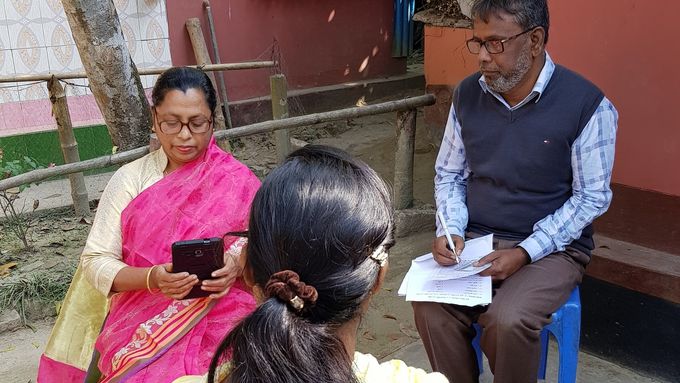Swiss TPH Designated as WHO Collaborating Centre for Verbal Autopsy
05.10.2022
The World Health Organization (WHO) has designated Swiss TPH as the WHO Collaborating Centre for Verbal Autopsy. The primary objective of verbal autopsy is to describe the pattern of causes of death that occur outside of medical care. As such, it has become an essential public health tool for identifying causes of death when a medical certificate is not readily available.

In verbal autopsy, a qualified interviewer uses a questionnaire to collect information about the signs, symptoms and demographic characteristics of a recently deceased person from someone who was familiar with them. (Photo courtesy of Moyeen Uddin and Shah Ali Akbar Ashrafi – Bloomberg Philanthropies Data for Health Initiative / Vital Strategies)
Reliable and comparable data on the causes of mortality are cornerstones for building a solid evidence base for health policy, planning, monitoring and evaluation. Ideally, a physician reports the cause of death using a standard medical certificate. However, in some settings, no doctor is available to see the deceased and to ascertain and report the medically certified cause of death. In such cases, a verbal autopsy (VA) can be used to determine the most probable cause of death.
With years of successful collaboration in VA research and implementation, the World Health Organization (WHO) has designated the Household Economics and Health Systems Research unit at Swiss TPH the Collaborating Centre for Verbal Autopsy.
“With countries in the world where less than 15% of the causes of death are known, how can governments know where to allocate its resources if it does not know why their citizens die?” said Aurelio Di Pasquale, Co-head of the WHO Collaborating Centre for VA. “In such cases, VA plays an important role in decision-making and policy development. As Swiss TPH has extensive experience with civil vital registration systems and has been supporting the WHO since 2015, we were selected as the WHO Collaborating Centre because of our commitment, technical skills and knowledge demonstrated over the past years."
"Planning health interventions without mortality statistics is like driving a car in the dark. While countries build their medical certification systems, verbal autopsy can provide extremely valuable information for decision makers," added Daniel Cobos Muñoz, who is co-heading the new WHO Collaborating Centre for VA with Aurelio Di Pasquale.
When no death certificate is available
In VA, the cause of death is identified on the basis of an interview with the next of kin or other caregivers. The interviewer uses a standardised questionnaire that asks for information about signs, symptoms, medical history and circumstances preceding the death. The cause of death or sequence of causes leading to death is determined from data collected with the VA questionnaire and other available information. The data collected from the questionnaire is interpreted using the clinical opinion of physicians or a computer algorithm to determine the cause of death.
In 2007, WHO released three standard VA questionnaires (for neonates, children and adults) to facilitate certification according to international standards and accurate determination of all causes of death. The standards have been regularly updated since then to improve cause-specific mortality data and ensure consistency and comparability between countries.[1] The WHO VA instrument is suitable for routine use and designed for all age groups, including maternal and childbirth deaths, as well as fatalities due to injury. The instrument relies on systematic reviews, expert consultations and extensive feedback from the field. [2]
WHO Collaborating Centre for Verbal Autopsy
As a WHO Collaborating Centre, Swiss TPH serves as a vital resource to assist WHO in the development, maintenance and revision of the WHO Verbal Autopsy instrument with the overall aim of enabling countries to strengthen data, analytics and health information systems to inform policy and achieve impact.
In particular, Swiss TPH will provide support for local and regional users of VA, and promote the use of the WHO Verbal Autopsy tool by developing and disseminating training materials, organising and conducting training courses and translating WHO international materials on Verbal Autopsy for local use in coordination with WHO. Further, Swiss TPH will facilitate the implementation of the WHO verbal autopsy tool by promoting quality assurance procedures related to mechanisms, norms and standards for the application of verbal autopsy, data collection and data analysis.
Swiss TPH will also contribute to the global network of WHO Collaborating Centres for FIC (Family of International Classifications). The WHO-FIC reference classifications and terminologies serve as global standards for health data, clinical documentation and statistical aggregation, allowing all healthcare workers and patients to communicate in a common technical language.
More about verbal autopsy
Chandramohan D, Fottrell E, Leitao J, Nichols E, Clark S J, Alsokhn C, Cobos Munoz D, AbouZahr C, Di Pasquale A, Mswia R, Choi E, Baiden F, Thomas J, Lyatuu I, Li Z, Larbi-Debrah P, Chu Y, Cheburet S, Sankoh O, Mohamed Badr A, Fat D M, Setel P, Jakob R & de Savigny D(2021) Estimating causes of death where there is no medical certification: evolution and state of the art of verbal autopsy. Global Health Action, 14:sup1, DOI: 10.1080/16549716.2021.1982486
Contact

Aurelio Di Pasquale
Dr.
Head of Research IT
+41612848702
aurelio.dipasquale@swisstph.ch

Daniel Cobos Muñoz
PhD, MD, MSc
Scientific Group Leader
+41612848720
daniel.cobos@swisstph.ch
Stay connected
Subscribe to our newsletter and get all the latest research news, project updates, course and event listings from Swiss TPH.